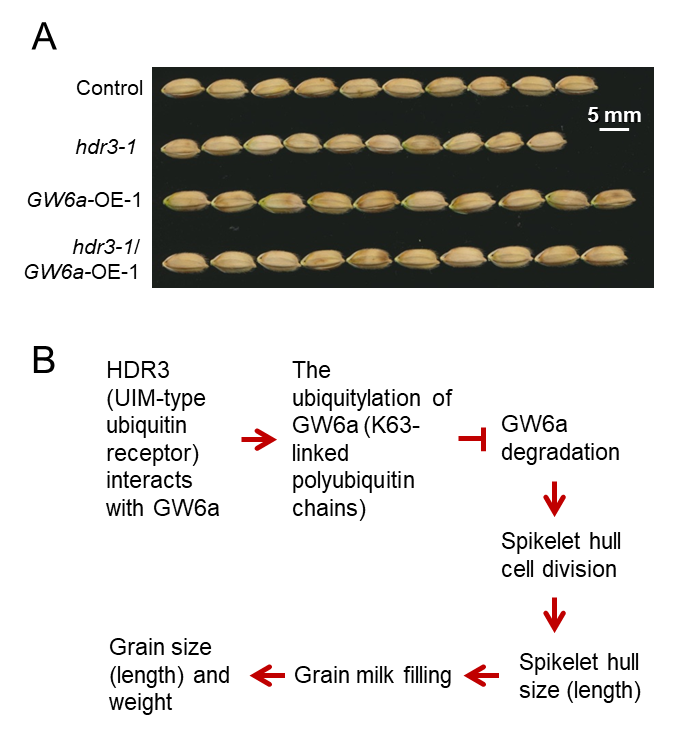Cultivated rice is an important crop that feeds more than half of the world’s population. Grain size in rice is a key agronomic trait determining grain yield. It is therefore of significant scientific interest and high-yield breeding implications to reveal new mechanisms underlying grain size control in rice.
In a study published in Plant Cell, Dr. SONG Xianjun's group from the Institute of Botany of the Chinese Academy of Sciences revealed a non-proteolysis mechanism underlying the regulation of rice grain size: the ubiquitin-interacting motif-containing protein HOMOLOGUE OF DA1 ON RICE CHROMOSOME 3 (HDR3) interacts with and is responsible for the increased lysine (K)63-linked polyubiquitination of GRAIN WEIGHT 6a (GW6a, a chromatin histone acetyltransferase); this type of polyubiquitination modification stabilizes, but not de-stabilizes as in most cases, GW6a to regulate grain size.
The researchers initially discovered that GW6a interacts with HDR3. On the basis of the results, they observed that transgenic rice plants over-expressing HDR3 produced larger grains, whereas HDR3 knockout lines generated smaller grains. Furthermore, cytological evidences supported that HDR3 modulates grain size in a similar manner to GW6a, by altering cell proliferation in spikelet hulls. In addition, RNA sequencing analyses and chromatin immunoprecipitation experiments revealed that HDR3 and GW6a bind to the promoters of and modulate a common set of downstream genes. Most importantly, genetic and molecular results support that HDR3 functions in a common pathway with GW6a to regulate grain size.
This study showed a novel protein interaction finding, revealed the HDR3-GW6a module fine-tuning grain size in rice and thus a previously known signaling mechanism. It will be interesting to further investigate the detailed mechanism of how this type of polyubiquitination delays protein degradation in the future.

HDR3 functions in a common genetic pathway with and upstream of GW6a, and a proposed model for the HDR3-GW6a regulation of grain size. (IBCAS)
Article Link: https://academic.oup.com/plcell/advance-article/doi/10.1093/plcell/koab194/6330630?guestAccessKey=1f429580-7c9f-4c9c-adb8-15c9fa779eec
Contact Info:
SONG Xianjun, the Institute of Botany, CAS
Email: songxj@ibcas.ac.cn
Cultivated rice is an important crop that feeds more than half of the world’s population. Grain size in rice is a key agronomic trait determining grain yield. It is therefore of significant scientific interest and high-yield breeding implications to reveal new mechanisms underlying grain size control in rice.
In a study published in Plant Cell, Dr. SONG Xianjun's group from the Institute of Botany of the Chinese Academy of Sciences revealed a non-proteolysis mechanism underlying the regulation of rice grain size: the ubiquitin-interacting motif-containing protein HOMOLOGUE OF DA1 ON RICE CHROMOSOME 3 (HDR3) interacts with and is responsible for the increased lysine (K)63-linked polyubiquitination of GRAIN WEIGHT 6a (GW6a, a chromatin histone acetyltransferase); this type of polyubiquitination modification stabilizes, but not de-stabilizes as in most cases, GW6a to regulate grain size.
The researchers initially discovered that GW6a interacts with HDR3. On the basis of the results, they observed that transgenic rice plants over-expressing HDR3 produced larger grains, whereas HDR3 knockout lines generated smaller grains. Furthermore, cytological evidences supported that HDR3 modulates grain size in a similar manner to GW6a, by altering cell proliferation in spikelet hulls. In addition, RNA sequencing analyses and chromatin immunoprecipitation experiments revealed that HDR3 and GW6a bind to the promoters of and modulate a common set of downstream genes. Most importantly, genetic and molecular results support that HDR3 functions in a common pathway with GW6a to regulate grain size.
This study showed a novel protein interaction finding, revealed the HDR3-GW6a module fine-tuning grain size in rice and thus a previously known signaling mechanism. It will be interesting to further investigate the detailed mechanism of how this type of polyubiquitination delays protein degradation in the future.

HDR3 functions in a common genetic pathway with and upstream of GW6a, and a proposed model for the HDR3-GW6a regulation of grain size. (IBCAS)
Article Link: https://academic.oup.com/plcell/advance-article/doi/10.1093/plcell/koab194/6330630?guestAccessKey=1f429580-7c9f-4c9c-adb8-15c9fa779eec
Contact Info:
SONG Xianjun, the Institute of Botany, CAS
Email: songxj@ibcas.ac.cn
